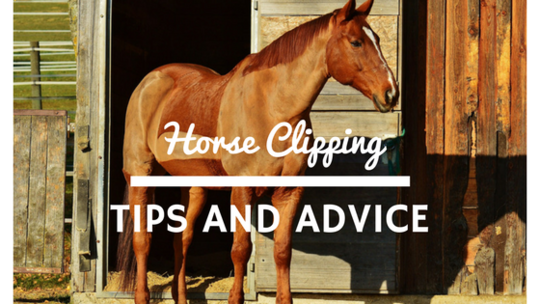
Are You & Your Horse Ready For Bitting Advice? The Steps You Need To Consider First
Equestrian Advice & Guides All Disciplines
Build your business profile for FREE and expose your services to thousands of potential clients!
Create my profile now!
Deciding whether or not to clip your horse will depend on what you are planning to do with your horse during the winter months. If you have a youngster or an older horse that is unlikely to be worked during this time, then leave him with his natural coat. Generally speaking, horses that are not in work do not require clipping.
If you have a horse that is terrified of clippers and is dangerous to himself and handler, it is better not to attempt to clip on grounds of safety. Some horses will settle under sedation, but this needs to be discussed fully with your vet as he will need to be present.
Horses that live 24/7 outdoors will need as much protection from the elements, and if a rug is not being used, then the horse will obviously need his full coat left on. Part clips can be considered if a rug and shelter is provided.
Most horses that are in light to moderate work or just being hacked out at the weekends will benefit from just having part of their coat removed. This will enable them to happily carry out the work required of them without becoming too hot and sweaty and will ensure that they dry off quickly without losing too much condition.
If no more than 50% of the coat is clipped, the animal can still live out quite happily throughout the winter, although adequate shelter will be needed and provision of a good waterproof outdoor rug is essential.
There are various part clips that can be used or adapted.
The Trace Clip or Trace High Clip
Where hair below the trace line is removed and from the lower neck and jaw.
The Bib Clip
Where the gullet and chest are clipped.
These three clips are ideal for the owner who is expecting to ride at weekends during the winter as it allows the horse to dry off quickly if he does get sweaty, but without taking away all his natural coat. If your horse is a little on the lively side, it is advisable to keep his back and quarters covered either by not clipping this area or by replacing with an exercise rug when riding.
For the horse owner who is expecting to work their horse daily and compete or hunt on a regular basis throughout the winter months, a more complete clip will be needed. This will allow the horse to remain in full work without losing condition through excess sweating, or risk chilling after exercise. The three main types of clip to consider are:-
The Full Clip
Where all the coat is removed including legs.
The Hunter Clip
Where all the coat is removed except the saddle area and the legs.
The Blanket Clip
Where all the hair is left on the upper half of the body acting as a natural exercise blanket.
For these types of clip most horses would be stabled at night and suitably rugged to compensate for the loss of coat and provided with a good waterproof outdoor rug for paddock use.
Before you begin to clip your horse you will want to ensure that it is fully prepared. You should always make sure all mud is removed as it will blunt the clippers making the entire clipping process much harder and more time consuming. You should also remove as much grease from the horse’s coat as possible, as this will also make the process run smoother.
It is also wise to ensure that your equipment is set up and is working well. You should also make sure that the circuit breaker is functioning properly as it is vital for your safety and the safety of your horse. Then, before you crack on you should tie your horse securely and provide it with a hay net to prevent it from getting bored.
You should also test the clippers on your horse’s shoulders. This will allow it to get used to the noise and vibrations, to ensure that it is comfortable and at ease when the clipping begins. Clipping the horse in a stable with a clean floor will make it much easier to clean up afterwards. Similarly, wear overalls or old clothes as horsehair can be quite hard to remove from clothing.
There are many different types of clips that you can do on your horse from a simple blanket clip to a full clip including legs and face.
To decide what type of clip to give your horse you need to analyse what you do on a daily basis with your horse. For example, a hunter in full work all through the winter will have a full clip just leaving a saddle patch for comfort under tack. This helps the horse not to overheat, sweat and foam when galloping.
Competition horses that are mostly stable kept will too have a full clip to look good when out and prevent overheating and taking long periods of time to cool down.
We recommend that field kept, horses in light work or older horses prone to arthritis are left with the back section and legs on to protect the joints etc.
Before starting your full clip leaving legs and half face, use your chalk to draw clear lines on the face and at the top of the legs so they are all even. This is an ideal clip for a horse or pony in full work but is turned out.
Take care on certain areas such as the belly and around the sheath/groin area and stifle. The skin in these areas is particularly sensitive so ensure your clippers are cool and you use your other hand to keep the skin flat.
Always start at the shoulder and take long even strokes, overlapping each time to prevent lines. Ask someone to help you clip the elbows as you will need the horse’s leg to be held up and forward. Be aware that horses are very sensitive and ticklish here so run the clippers slowly and gently around the joint.
A blanket clip is the style of cutting a horse's coat when it is longer during the winter months. Giving your horse a blanket clip helps the horse to stay cool; having lots of hair under the saddle blanket is not comfortable for the horse. Horses are brilliant at storing heat but not losing it so you have to help them regulate their temperature by giving them a blanket clip. Clipping is simple and makes a great deal of difference.
For In-depth videos and a step-by-step guide on how to clip professionally, visit our youtube channel: https://www.youtube.com/user/HorsemartVideos

